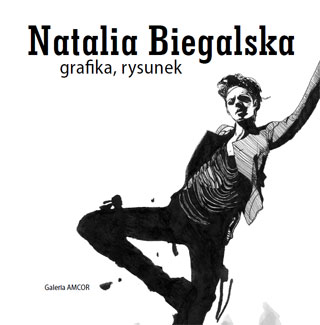 |
|
Natalia Biegalska »
GRAPHICS DRAWINGS


The characters of Natalia Biegalska's works live in a cramped, sometimes
even claustrophobic space. Depicted outside, they also have hardly any
space around. The images' background is shallow and simplified, in most
drawings and graphic works it is purged of any superfluous details.
Even works that are deprived of human image present the territory that
is closed to a large extent, composed of cuboid forms, cold, as if observed
through a narrow slit. There is little sky there, it has been shaded by
a soaring massif of mountains. What is essential here is that the space
is not defined either - we do not know its exact dimensions, character
and other attributes.
As a result of that way of creating the world it is human figures who move
forward to the foreground. What is more the artist explicitly foreshortens
the perspective, like in a film close-up the characters of her drawings and
graphic works are exposed to our voyeurism, trying to keep eye contact
with us, though usually a little bit embarrased.
The portrayed figures (real and invented characters) are literally and
metaphorically lonely. They got stuck in almost absolute desolation,
the external world does not symphatise with their little dramas'.
Despite the viewer's vivisection the young people stay anonymous.
It is so even though they are certainly created, individually defined.
Some of them look as if they were spontaneous and uncompromising
- however, their gestures manifesting independence are theatrical rather
than authentic. It seems that the expression of boredom hides the feeling
of uncertainty and confusion. The figures' face expression, seemingly
neutral, creates the atmosphere of sorrow and reflection.
The characters appear to be in a way excluded from our world although they
are in the limelight.
Moreover they were - literally and metaphorically - nearly applied' into
the reality. There are a lot of drawings that are collages; layers are actually
overlaid, which helps the drawings shift from plane to space perspective.
Even the graphic works appear to be composed of overlapping colour
layers.
The works are close to monochromatism. Their coloring, selected with
regard to the mood they are to create, is limited to the hues of greys, blues
and browns, enriched by red there and here. In graphic works colour is also
treated in a textural way - coloured planes are coarse and often blurred,
do not converge with contours of forms.
In most works drawing - an artistic gesture - is dynamic. Thickened
lines make up a kind of net in which the characters are detained, it closes
them in the multitude of connections and relationships which we can just
presume. Some works suggest it more explicitly, showing a whirl of stems
weaving around the figures' bodies in the image layer.
In her works the artist reveals a skill to use conceptual and formal
simplifications. She is keen on the poetic of the book and poster illustration.
Numerous literary and musical inspirations are dominated by those which
create the mood of anxiety, chill and mystery (though some graphic works
do not avoid sarcastic grotesque).
To some extent the selection of authors and references to specific motives
accounts for the reflection of personality and fascinations of the very artist,
yet the way they influence the creation of the world's vision in her works
lets us presume that Natalia Biegalska does not offer us merely a kind
of artistic exhibitionism. Her work might be regarded as a kind of more
universal diagnosis concerning the contemporary world and the position
of man (particularly the young one) in the homogenized and hostile reality,
in the world of unstable - or perhaps absent - values, facing the lack
of guideposts in the world of chaos and inner confusion.
In the artist's work man - the main subject of her interest - does not gain
the value of a symbol, as we could expect. They do not stand in the centre
of metaphorical space. The figures here are deprived of their realistic,
detailed context, they are left isolated, lonely and somewhat helpless.
In that kind of the world's perception there are certainly the echoes
of different traditions, including the existential tradition. If we could talk
about a kind of diagnosis - formulated by artistic means of expression
- it is rather a message concerning the condition of the times and man
who lives here and now.
Natalia Biegalska's work can be described as the creation of foreshortened
perspective' - the observation of man and human dilemmas in the close-up
is one of the manifestations of such a way of reality perception.
The young artist seeks a language of her own, at the same time she takes
advantage of a variety of graphic techniques: etching, drypoint, woodcut.
She uses them with great skill. The means of expression characteristic of
particular works undoubtedly harmonize with the essence of the emotional
message. It is certainly the way towards sophisticated simplicity
- tranquillised, yet louder than the frequently used circumlocution.
Dariusz Leśnikowski
Transl. Elżbieta Rodzeń-Leśnikowska

 KATALOG
KATALOG
|
|
|
 |










